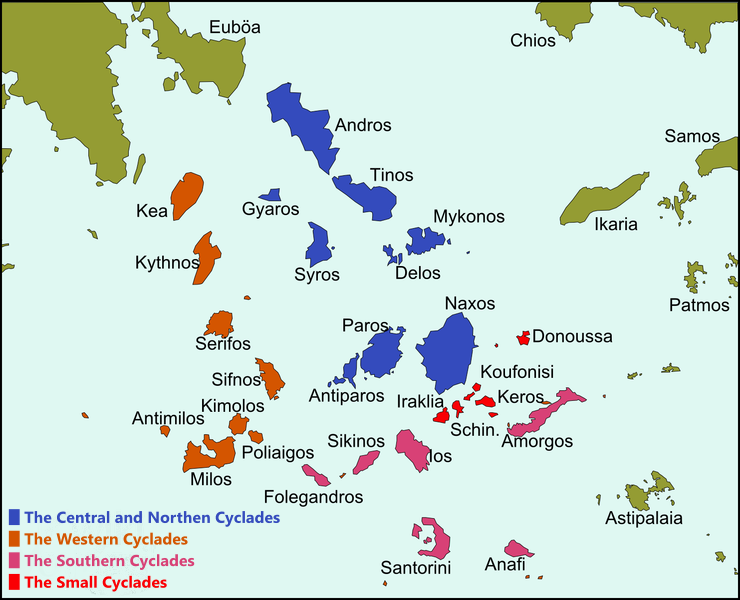- Map of the Cyclades
- Introduction to the Cyclades
- Amorgos
- Anafi
- Andros
- Antiparos
- Delos
- Folegandros
- Ios
- Kea (Keos or Tzia)
- Kimolos
- Kythnos
- Milos
- Mykonos
- Naxos
- Paros
- Santorini
- Serifos
- Sifnos
- Sikinos
- Syros
- Thirasia
- Tinos
Introduction to the Cyclades
The islands of the Cyclades are located in the central, southern part of the Aegean Sea extending from Andros in the north to Santorini in the south, and from Kea in the west to Amorgos in the east. The island group comprises some 2,200 islands, islets and rocks, of which just 33 islands are inhabited.
The name derives from the Greek word for a circle, Kyklos (κύκλος), with the sacred island of Delos, birthplace of Apollo, being the centre around which the other islands radiate. In Greek mythology, the Cyclades were sea-nymphs who Poseidon, the god of the sea, turned into rocks in a fit of rage. In reality, the islands are the peaks of an undersea mountain range, two of which, Milos and Santorini, erupted to form the volcanic islands of today.
The clichéd image of sun-kissed islands topped by dazzling white sugar-cubist villages with golden beaches lapped by turquoise seas under a cobalt blue sky largely holds true. It may be a holiday paradise, but away from the tourist hotspots you’ll find another world of rural villages, traditional customs and a slower pace of life, where real working donkeys carry impossibly-heavy loads through the steep labyrinthine streets and alleys, and where the chic bars of the resorts, filled with multilingual chit-chat, give way to the kafeneion, the clack-clack of backgammon pieces hitting the board and the clamour of Greek men discussing the world and life with a passion and volume that might lead you to believe that World War III is about to break out.
Early civilisations flourished in the region and widespread archaeological remains have been discovered; just about every island has at least one site of significant importance, and several islands have many. Excavations continue and more exciting discoveries are yet to be made, especially, it is thought, on the island of Keros in the Small Cyclades. The wealth of beautiful and exquisite finds have largely been retained within the islands and many can be seem in the islands’ archaeological museums. For millennia, the waters of the Aegean Sea were the highways carrying the trade routes between east and west. Empires came and went, each leaving their mark on the islands; the Minoans, the Mycenaeans, the Egyptians, the Romans, the Byzantines, the Venetians and the Ottoman Turks all contributed to the DNA of the islands.
In the 1960s, the Cyclades were ‘discovered’ by the beautiful people and, after decades of economic langour, the islands began to develop on the back of waves of tourists attracted by the unspoilt island villages, beautiful natural scenery, idyllic beaches and the laid-back island lifestyle.
Each island has its own unique character with no two islands being alike. The busiest resorts in the larger islands can, at times, seem like any other holiday location, but, scratch the surface a little, delve deeper than just the tourist veneer and you’ll discover another Greece that is impossible not to grow to love. You can walk for kilometre after kilometre on ancient footpaths through magnificent scenery, past Byzantine chapels and centuries-old dovecotes, and not see another soul. You’ll find beaches that the world seems to have forgotten and you can swim, as you please, in crystal-clear water. The towns and the villages are crammed full of history and nowhere in Europe, and possibly even the world, is there such a density of ancient sites waiting to stir your imagination. Of course, the weather is famously fantastic for most of the year and this gives rise to some excellent wines and some delicious local dishes and specialities that you should try instead of the usual staples of the Greek tourist menu, delicious as they may be.
Theodore and Mabel Bent visited 21 of the islands in 1882-1884 and you can follow their itinerary today to take you to places that you’ll never regret visiting. Along the way you’ll certainly have some great adventures and you’ll feel like a true explorer yourself at the end. There is a real danger though — not too far into your adventure, you’ll have fallen in love with those sea-nymphs called the Cyclades and you’ll undoubtedly be smitten for life!

